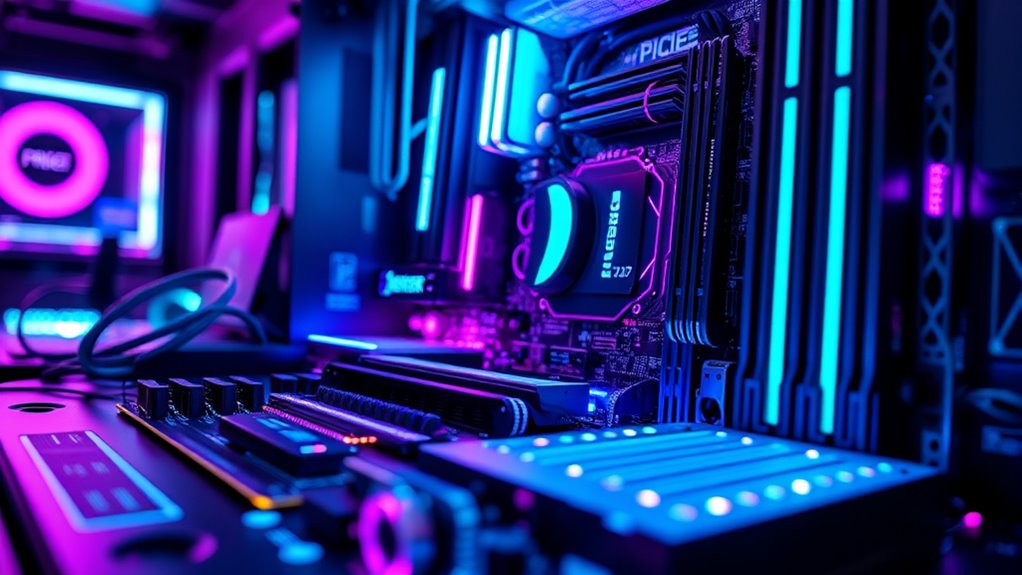PCIe 6.0 and 7.0 are transforming workstation performance with faster data transfer speeds, making tasks like AI processing and video editing more efficient. To fully leverage these upgrades, you’ll need to update compatible hardware such as motherboards, GPUs, and SSDs, and stay aware of compatibility challenges. Planning your system upgrade carefully guarantees you stay at the cutting edge. Keep exploring to discover how these standards can open your workstation’s full potential.
Key Takeaways
- PCIe 6.0 doubles data transfer speeds to 64 GT/s, while PCIe 7.0 targets up to 128 GT/s, enabling faster workstation performance.
- Upgrading to PCIe 6.0 or 7.0 requires compatible hardware components and firmware updates for optimal support.
- Compatibility challenges may necessitate hardware replacements and careful planning to prevent bottlenecks in workstation upgrades.
- Future workstation roadmaps emphasize adopting PCIe 6.0 and 7.0 to ensure scalability for high-bandwidth applications.
- Strategic planning and staying informed about chipset support are crucial for seamless transition to the latest PCIe standards.

As technology continues to advance rapidly, PCIe standards are evolving to meet increasing data transfer demands. You need to keep up with these changes because they directly impact the performance and future-proofing of your workstations. PCIe 6.0 and 7.0 aim to deliver unprecedented data transfer speeds, but they also introduce compatibility challenges that you’ll need to navigate carefully. The leap from PCIe 5.0 to PCIe 6.0 doubles the data throughput, reaching up to 64 GT/s (gigatransfers per second). This means faster access to large datasets, quicker file transfers, and better performance for high-bandwidth applications like AI, video editing, and scientific computing. As you upgrade your systems, you’ll notice that hardware components—motherboards, GPUs, SSDs—must be compatible with these new standards. Ensuring compatibility isn’t always straightforward because not all existing hardware supports PCIe 6.0 or 7.0. You might face challenges in finding compatible components or need to update firmware and BIOS to enable full utilization of the new standards. Additionally, hardware support is critical for making the most of these advancements, highlighting the importance of choosing components that are compatible with upcoming standards.
PCIe 7.0 promises even higher speeds, potentially reaching up to 128 GT/s. This progression means data transfer speeds will become almost instantaneous for many tasks, streamlining workflows and reducing bottlenecks. However, these advancements come with their own set of compatibility challenges. Your current hardware architectures may need significant upgrades, and backward compatibility might not be guaranteed across all devices. You could encounter issues where older components don’t work seamlessly with the latest PCIe standards, forcing you to replace or upgrade multiple parts. This process requires careful planning to avoid bottlenecks or mismatched interfaces that could hamper overall system performance.
Staying ahead in your workstations means understanding these evolving standards and their implications. As PCIe 6.0 and 7.0 mature, you’ll need to weigh the benefits of faster data transfer speeds against the costs and effort involved in upgrading hardware. Compatibility challenges can slow down your progress if not managed properly, so it’s essential to research hardware compatibility, firmware updates, and chipset support beforehand. The progression to these new standards is not just about raw speed; it’s about future-proofing your systems and ensuring you can leverage the full potential of upcoming technologies. By being proactive, you’ll be better prepared to adopt PCIe 6.0 and 7.0 when they become mainstream, keeping your workstations at the cutting edge of performance and efficiency.
Frequently Asked Questions
Will PCIE 6.0 and 7.0 Support Future AI Workloads?
Yes, PCIe 6.0 and 7.0 will support future AI workloads. They boost data throughput considerably, enabling faster AI acceleration. With higher bandwidth, you’ll experience improved performance when transferring large datasets and working with advanced AI models. This means smoother, more efficient AI training and inferencing. As AI demands grow, these PCIe standards will ensure your workstation stays capable of handling the increasing data and processing needs.
How Will Backward Compatibility Be Maintained With Older PCIE Versions?
Backward compatibility will be maintained through legacy support and adapter compatibility, ensuring your older devices still work with new PCIe versions. You’ll find that new motherboards and expansion cards are designed to support previous PCIe standards, allowing seamless integration. This means you won’t need to replace all your components immediately, and your system can adapt as the technology advances without sacrificing performance or connectivity.
What Are the Estimated Costs for Upgrading to PCIE 6.0 and 7.0?
You can expect the cost estimation for upgrading to PCIe 6.0 and 7.0 to vary based on your existing hardware and the components you need. Upgrade expenses generally include new motherboards, compatible CPUs, and peripherals, which might increase overall costs. While prices are still emerging, budget for a few hundred dollars to cover necessary components and guarantee compatibility. Planning ahead helps you manage upgrade expenses effectively.
Are There Specific Workstations Optimized for PCIE 6.0 and 7.0?
You’ll find workstations optimized for PCIe 6.0 and 7.0 in high-end, enterprise-grade models designed with advanced workstation design and hardware compatibility in mind. For example, a recent case study shows a workstation built specifically for AI workloads that seamlessly integrates the latest PCIe standards. These systems ensure you maximize bandwidth and performance, but you need to verify if your hardware supports these cutting-edge PCIe versions before upgrading.
How Do PCIE 6.0 and 7.0 Impact Overall System Latency?
You’ll notice that PCIe 6.0 and 7.0 substantially reduce signal latency, which means data moves faster and more efficiently. This improved signal latency leads to quicker response times, especially in high-performance workstations. Additionally, the increased data throughput allows for handling larger data transfers without bottlenecks. Overall, these upgrades boost system responsiveness and productivity, making your workstation more capable of demanding tasks.
Conclusion
As you step into the future of workstations, PCIe 6.0 and 7.0 promise lightning-fast speeds and unprecedented performance, like something out of a sci-fi flick. Staying ahead means embracing these advancements now, so you’re ready for whatever tomorrow holds. Just remember, even in this brave new world, a little bit of patience—like waiting for the next great invention—will reward you with cutting-edge power that transforms your workflow for years to come.










